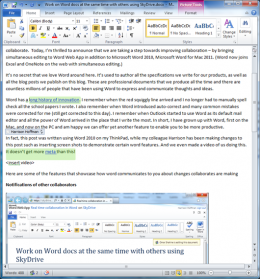July 8, 2011 weblog
Microsoft adds a collaboration feature to the Word Web App

(PhysOrg.com) -- Microsoft is looking to make a move into Google's office suite functionality on the web. They announced on the Windows Live blog that they are adding a new feature to the Word Web App and that is real time collaboration. While this feature already existed in two of the Microsoft products, Excel and OneNote, it was one of the most requested features for the Word Web App.
Of course; users who really needed the feature were most likely already using Google Docs. Since the creation of Google Docs in 2007, three years before Microsoft decided to launch a web apps suite, the company has through the use of judicious acquisitions of companies create a full-featured web based office suite that allows for multi-user collaboration and more specifically the collaborative editing feature that Microsoft has just announced.
So comparisons will undoubtedly be made between the two setups in the next few days and weeks as people compare the existing product to Microsoft's later offering. Not that these types of comparisons have gone well for Microsoft in the past, think about the Zune and the Windows phone if you want to see how that has gone for them in the past.
The system allows users to be notified if the document is being edited by someone else. Sadly, it also locks you out of the section of the document that person is working on, so making and actual changes at the same time is still not possible, which seems a little antithetical, at least not until after they save. The system was used to make the announcement on the Windows Live blog.
More information: Windows team blog
© 2010 PhysOrg.com


















